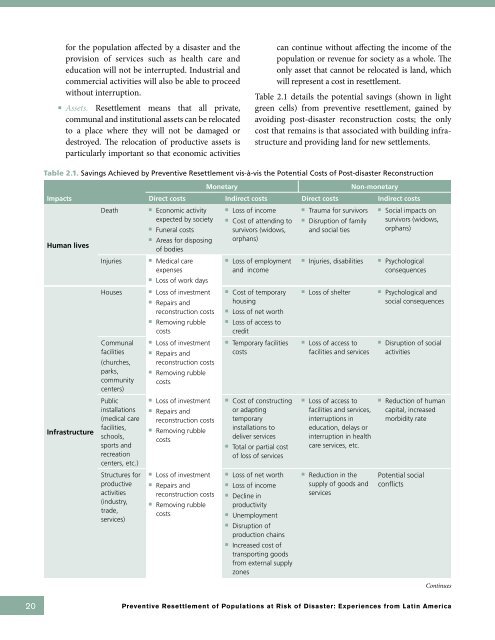Preventive Resettlement of Populations at Risk of Disaster - GFDRR
Preventive Resettlement of Populations at Risk of Disaster - GFDRR
Preventive Resettlement of Populations at Risk of Disaster - GFDRR
You also want an ePaper? Increase the reach of your titles
YUMPU automatically turns print PDFs into web optimized ePapers that Google loves.
■■<br />
for the popul<strong>at</strong>ion affected by a disaster and the<br />
provision <strong>of</strong> services such as health care and<br />
educ<strong>at</strong>ion will not be interrupted. Industrial and<br />
commercial activities will also be able to proceed<br />
without interruption.<br />
Assets. <strong>Resettlement</strong> means th<strong>at</strong> all priv<strong>at</strong>e,<br />
communal and institutional assets can be reloc<strong>at</strong>ed<br />
to a place where they will not be damaged or<br />
destroyed. The reloc<strong>at</strong>ion <strong>of</strong> productive assets is<br />
particularly important so th<strong>at</strong> economic activities<br />
can continue without affecting the income <strong>of</strong> the<br />
popul<strong>at</strong>ion or revenue for society as a whole. The<br />
only asset th<strong>at</strong> cannot be reloc<strong>at</strong>ed is land, which<br />
will represent a cost in resettlement.<br />
Table 2.1 details the potential savings (shown in light<br />
green cells) from preventive resettlement, gained by<br />
avoiding post-disaster reconstruction costs; the only<br />
cost th<strong>at</strong> remains is th<strong>at</strong> associ<strong>at</strong>ed with building infrastructure<br />
and providing land for new settlements.<br />
Table 2.1. Savings Achieved by <strong>Preventive</strong> <strong>Resettlement</strong> vis-à-vis the Potential Costs <strong>of</strong> Post-disaster Reconstruction<br />
Impacts<br />
Human lives<br />
Infrastructure<br />
De<strong>at</strong>h<br />
Injuries<br />
Houses<br />
Communal<br />
facilities<br />
(churches,<br />
parks,<br />
community<br />
centers)<br />
Public<br />
install<strong>at</strong>ions<br />
(medical care<br />
facilities,<br />
schools,<br />
sports and<br />
recre<strong>at</strong>ion<br />
centers, etc.)<br />
Structures for<br />
productive<br />
activities<br />
(industry,<br />
trade,<br />
services)<br />
Monetary<br />
Non-monetary<br />
Direct costs Indirect costs Direct costs Indirect costs<br />
■■<br />
Economic activity ■■<br />
Loss <strong>of</strong> income<br />
■■<br />
Trauma for survivors ■■<br />
expected by society ■■<br />
■■<br />
■■<br />
■■<br />
■■<br />
■■<br />
■■<br />
■■<br />
■■<br />
■■<br />
■■<br />
■■<br />
■■<br />
■■<br />
■■<br />
■■<br />
■■<br />
■■<br />
Funeral costs<br />
Areas for disposing<br />
<strong>of</strong> bodies<br />
Medical care<br />
expenses<br />
Loss <strong>of</strong> work days<br />
Loss <strong>of</strong> investment<br />
Repairs and<br />
reconstruction costs<br />
Removing rubble<br />
costs<br />
Loss <strong>of</strong> investment<br />
Repairs and<br />
reconstruction costs<br />
Removing rubble<br />
costs<br />
Loss <strong>of</strong> investment<br />
Repairs and<br />
reconstruction costs<br />
Removing rubble<br />
costs<br />
Loss <strong>of</strong> investment<br />
Repairs and<br />
reconstruction costs<br />
Removing rubble<br />
costs<br />
■■<br />
■■<br />
■■<br />
■■<br />
■■<br />
■■<br />
■■<br />
■■<br />
■■<br />
■■<br />
■■<br />
■■<br />
■■<br />
Cost <strong>of</strong> <strong>at</strong>tending to<br />
survivors (widows,<br />
orphans)<br />
Loss <strong>of</strong> employment<br />
and income<br />
Cost <strong>of</strong> temporary<br />
housing<br />
Loss <strong>of</strong> net worth<br />
Loss <strong>of</strong> access to<br />
credit<br />
Temporary facilities<br />
costs<br />
Cost <strong>of</strong> constructing<br />
or adapting<br />
temporary<br />
install<strong>at</strong>ions to<br />
deliver services<br />
Total or partial cost<br />
<strong>of</strong> loss <strong>of</strong> services<br />
Loss <strong>of</strong> net worth<br />
Loss <strong>of</strong> income<br />
Decline in<br />
productivity<br />
Unemployment<br />
Disruption <strong>of</strong><br />
production chains<br />
Increased cost <strong>of</strong><br />
transporting goods<br />
from external supply<br />
zones<br />
Disruption <strong>of</strong> family<br />
and social ties<br />
Social impacts on<br />
survivors (widows,<br />
orphans)<br />
■■<br />
Injuries, disabilities ■■<br />
Psychological<br />
consequences<br />
■■<br />
Loss <strong>of</strong> shelter ■■<br />
Psychological and<br />
social consequences<br />
■■<br />
■■<br />
■■<br />
Loss <strong>of</strong> access to<br />
facilities and services<br />
Loss <strong>of</strong> access to<br />
facilities and services,<br />
interruptions in<br />
educ<strong>at</strong>ion, delays or<br />
interruption in health<br />
care services, etc.<br />
Reduction in the<br />
supply <strong>of</strong> goods and<br />
services<br />
■■<br />
■■<br />
Disruption <strong>of</strong> social<br />
activities<br />
Reduction <strong>of</strong> human<br />
capital, increased<br />
morbidity r<strong>at</strong>e<br />
Potential social<br />
conflicts<br />
Continues<br />
20 <strong>Preventive</strong> <strong>Resettlement</strong> <strong>of</strong> <strong>Popul<strong>at</strong>ions</strong> <strong>at</strong> <strong>Risk</strong> <strong>of</strong> <strong>Disaster</strong>: Experiences from L<strong>at</strong>in America
















